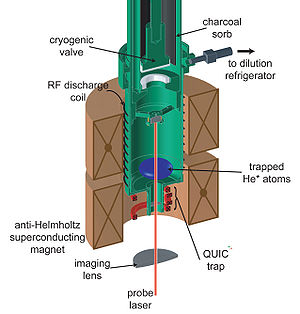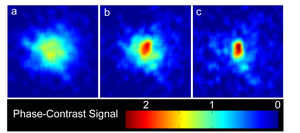Difference between revisions of "BEC"
m (→Recent Publications) |
(→People) |
||
| (8 intermediate revisions by 3 users not shown) | |||
| Line 3: | Line 3: | ||
==People== | ==People== | ||
| − | *Charlie Doret | + | *Charlie Doret (Now a professor at [Harvey Mudd http://physics.hmc.edu/faculty/19/]) |
| − | *Colin Connolly | + | *Colin Connolly (Now working on [[NH|N/NH]]) |
| − | *Yat Shan Au | + | *Yat Shan Au (Now working on [[NH|N/NH]]) |
=Metastable Helium BEC= | =Metastable Helium BEC= | ||
[[image:BEC_cell.jpg|thumb|left|The G-10 cell and trapping magnets.]] [[image:He_BEC_formation.jpg|thumb|right|Phase-contrast images of 4He* in 1 ms TOF, showing BEC formation. (a) a thermal cloud slightly above Tc. (b) onset of BEC. (c) a nearly pure BEC after further evaporative cooling.]] | [[image:BEC_cell.jpg|thumb|left|The G-10 cell and trapping magnets.]] [[image:He_BEC_formation.jpg|thumb|right|Phase-contrast images of 4He* in 1 ms TOF, showing BEC formation. (a) a thermal cloud slightly above Tc. (b) onset of BEC. (c) a nearly pure BEC after further evaporative cooling.]] | ||
| − | We have utilized buffer-gas methods to demonstrate Bose-Einstein condensation of 4He* without the use of laser pre-cooling. These methods are readily extendable to any paramagnetic species with typical collisional parameters that allow for efficient evaporative cooling, significantly extending the scope of ultracold atom/molecule research. The experiment takes place in a G-10 cell, coaxially inside the bore of a 4 T deep superconducting anti-Helmholtz magnetic trap and thermally anchored to a dilution refrigerator. 4He* is excited via RF discharge with an efficiency of 10^-5 | + | We have utilized buffer-gas methods to demonstrate Bose-Einstein condensation of 4He* without the use of laser pre-cooling. These methods are readily extendable to any paramagnetic species with typical collisional parameters that allow for efficient evaporative cooling, significantly extending the scope of ultracold atom/molecule research. The experiment takes place in a G-10 cell, coaxially inside the bore of a 4 T deep superconducting anti-Helmholtz magnetic trap and thermally anchored to a dilution refrigerator. 4He* is excited via RF discharge from a 4He buffer gas with an efficiency of 10^-5 and cooled to the refrigerator temperature by collisions with the remaining buffer gas. The buffer gas is cryo-pumped to a charcoal sorb, leaving approximately 10^11 4He* atoms trapped in the magnetic field. The atom cloud is then evaporatively cooled to 1 mK by surface-induced evaporation, forced by asymmetrically reducing the currents to the anti-Helmholtz coils. Atoms are then transferred to a tightly confining, superconducting quadrupole-Ioffe configuration (QUIC) trap to prevent Majorana losses. After transferring the atoms evaporative cooling continues, now using an RF knife. In the present apparatus we observe BEC formation at a temperature of 5 uK with approximately 10^6 atoms remaining, while further evaporative cooling create nearly-pure condensates of 2-300,000 atoms. Geometric constraints currently limit the transfer of atoms to the QUIC trap to 5% efficiency; straightforward improvements should produce condensates of 10^7 atoms. |
Click here for 2009 GRC poster:[http://cua.harvard.edu/pub/talks_and_posters/He_BEC_GRC_2009.pdf He_BEC_GRC_2009_poster.pdf] | Click here for 2009 GRC poster:[http://cua.harvard.edu/pub/talks_and_posters/He_BEC_GRC_2009.pdf He_BEC_GRC_2009_poster.pdf] | ||
| Line 17: | Line 17: | ||
=Recent Publications= | =Recent Publications= | ||
| − | # [http:// | + | # [http://pra.aps.org/abstract/PRA/v81/i1/e010702 Large spin relaxation rates in trapped submerged-shell atoms], C. B. Connolly, Y. S. Au, S. C. Doret, W. Ketterle, J. M. Doyle. Phys. Rev. A 81, 010702(R) (2010). |
| + | # [[Media:PRL_103_103005_2009.pdf| Buffer-gas cooled Bose-Einstein condensate]], S. C. Doret, C. B. Connolly, W. Ketterle, and J. M. Doyle. PRL '''103''', 103005 (2009). | ||
# [http://jsbach.harvard.edu/resources/bufferprints/Mn_paper.pdf Spin-exchange collisions of submerged shell atoms below 1 kelvin], J.G.E. Harris, S.V. Nguyen, S.C. Doret, W. Ketterle, and J.M. Doyle. Physical Review Letters, 99, 223201 (2007). | # [http://jsbach.harvard.edu/resources/bufferprints/Mn_paper.pdf Spin-exchange collisions of submerged shell atoms below 1 kelvin], J.G.E. Harris, S.V. Nguyen, S.C. Doret, W. Ketterle, and J.M. Doyle. Physical Review Letters, 99, 223201 (2007). | ||
# [http://jsbach.harvard.edu/resources/bufferprints/PhysRevA_72_060703.pdf Evaporative cooling of metastable helium in the multi-partial-wave regime], S.V. Nguyen, S.C. Doret, C.B. Connolly, R.A. Michniak, W. Ketterle, and J.M. Doyle. Phys. Rev. A, 72, 060703(R) (2005). | # [http://jsbach.harvard.edu/resources/bufferprints/PhysRevA_72_060703.pdf Evaporative cooling of metastable helium in the multi-partial-wave regime], S.V. Nguyen, S.C. Doret, C.B. Connolly, R.A. Michniak, W. Ketterle, and J.M. Doyle. Phys. Rev. A, 72, 060703(R) (2005). | ||
Latest revision as of 07:51, 22 October 2012
Contents
Overview
Despite innumerable experimental advances, research with degenerate Bose and Fermi gases has remained limited to only a handful of atomic species since its inception due to the field's reliance on laser pre-cooling as the first step towards quantum degeneracy. Developmening new cooling methods applicable to a wider range of atoms and also to molecules and extendable to the ultracold regime is thus important for taking full advantage of scientific opportunities in new areas.
People
- Charlie Doret (Now a professor at [Harvey Mudd http://physics.hmc.edu/faculty/19/])
- Colin Connolly (Now working on N/NH)
- Yat Shan Au (Now working on N/NH)
Metastable Helium BEC
We have utilized buffer-gas methods to demonstrate Bose-Einstein condensation of 4He* without the use of laser pre-cooling. These methods are readily extendable to any paramagnetic species with typical collisional parameters that allow for efficient evaporative cooling, significantly extending the scope of ultracold atom/molecule research. The experiment takes place in a G-10 cell, coaxially inside the bore of a 4 T deep superconducting anti-Helmholtz magnetic trap and thermally anchored to a dilution refrigerator. 4He* is excited via RF discharge from a 4He buffer gas with an efficiency of 10^-5 and cooled to the refrigerator temperature by collisions with the remaining buffer gas. The buffer gas is cryo-pumped to a charcoal sorb, leaving approximately 10^11 4He* atoms trapped in the magnetic field. The atom cloud is then evaporatively cooled to 1 mK by surface-induced evaporation, forced by asymmetrically reducing the currents to the anti-Helmholtz coils. Atoms are then transferred to a tightly confining, superconducting quadrupole-Ioffe configuration (QUIC) trap to prevent Majorana losses. After transferring the atoms evaporative cooling continues, now using an RF knife. In the present apparatus we observe BEC formation at a temperature of 5 uK with approximately 10^6 atoms remaining, while further evaporative cooling create nearly-pure condensates of 2-300,000 atoms. Geometric constraints currently limit the transfer of atoms to the QUIC trap to 5% efficiency; straightforward improvements should produce condensates of 10^7 atoms.
Click here for 2009 GRC poster:He_BEC_GRC_2009_poster.pdf
Two-body collisions in thulium and erbium
Since producing our 4He* BEC we have been investigating two-body atom-atom collisional properties of the "submerged-shell" rare-earth atoms thulium and erbium using the same apparatus. Previous research in our lab indicated that the submerged-shell nature of these atoms gives rise to strong suppression of inelastic processes during atom-helium collisions. Similar suppression of inelastic collisions in atom-atom collisions would permit efficient evaporative cooling and make these atoms excellent candidates for new quantum degenerate gases, accessible using our new buffer-gas BEC approach.
Recent Publications
- Large spin relaxation rates in trapped submerged-shell atoms, C. B. Connolly, Y. S. Au, S. C. Doret, W. Ketterle, J. M. Doyle. Phys. Rev. A 81, 010702(R) (2010).
- Buffer-gas cooled Bose-Einstein condensate, S. C. Doret, C. B. Connolly, W. Ketterle, and J. M. Doyle. PRL 103, 103005 (2009).
- Spin-exchange collisions of submerged shell atoms below 1 kelvin, J.G.E. Harris, S.V. Nguyen, S.C. Doret, W. Ketterle, and J.M. Doyle. Physical Review Letters, 99, 223201 (2007).
- Evaporative cooling of metastable helium in the multi-partial-wave regime, S.V. Nguyen, S.C. Doret, C.B. Connolly, R.A. Michniak, W. Ketterle, and J.M. Doyle. Phys. Rev. A, 72, 060703(R) (2005).

